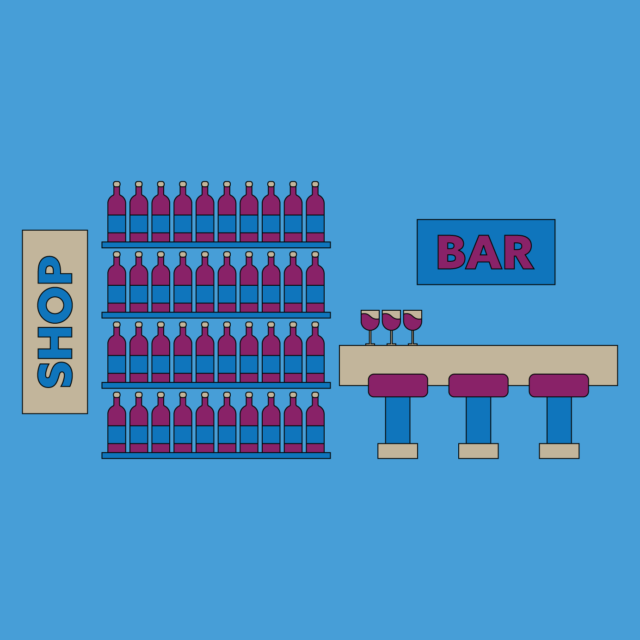When you order wine at a restaurant, it invariably costs more than if you bought that same bottle in a store and drank it on your couch. Bumping up the cost of booze is how restaurants pay their employees, utility bills, and rent — but you already know all that.
You’d be forgiven, however, for not being entirely sure what to expect to pay at the array of hybrid wine shops-slash-bars popping up nationwide. Venues like Park Avenue Wines in Portland, Ore., Graft in Charleston, S.C., and others blur the lines between restaurant and retailer, selling bottles you can either take home or drink on the spot. Some offer cocktails and wines by the glass, too. There’s usually table service. There might even be snacks.
What, then, does it cost to drink in one of these bars? Are bottle prices the same in the bar and the store? And are you supposed to tip?
“I think it is important to have a solid sound bite for guests in regards to pricing… Folks love transparency,” Jill Roberts says. Roberts worked as a sommelier at New York City’s Eleven Madison Park and other restaurants before opening The Hawthorn, a wine shop and bar in Helena, Mont., in 2015.
Like many other hybrid spaces, The Hawthorn adds a flat fee of $10 to the retail price of a bottle from the shop if you want to drink it on-site. It’s a standardized rate, akin to the corkage fee for bringing your own wine to a restaurant.
The same principle guides pricing at Park Avenue Wines, a combination shop and wine bar in downtown Portland, Ore. “The space is all connected, so if someone grabs a bottle from our shop, they can just wander over and bring it to the bar. It’s that price right off the shelf plus $10 on top,” owner Stacey Gibson says.
Other wine shop hybrids, such as The Royce in Detroit, Mich., and 1340 Beer Wine Spirits in Chicago, also add $10 per bottle if you want to stick around and drink. Charleston, S.C.’s Graft has a $15 fee.
If you open two bottles from the shop at these bars, expect to pay the fee twice. And if a server comes to your table, opens your bottle, and refills glasses, tip as you would in a restaurant. “Guests on average tip 20 percent,” Roberts says.
That might sound like a lot of money to essentially use someone else’s corkscrew and glassware, but the majority of those fees go toward operational and labor costs. At a shop you might spend 15 minutes, Gibson explains, whereas guests at a wine bar will stay an hour or more, helped by a server who needs to be compensated for their time, in a space that has rent, property taxes, and water and electric bills. “In that sense, $10 is an absolute steal,” she says.
Fees also help independent businesses offset the costs of the licenses required to sell and serve alcohol. “Currently, our type of license will sell for $240,000 and up,” Roberts says. “This really makes it tough for small businesses. They often get sucked up by chains or franchises.”
By-the-glass (BTG) pricing in bars and restaurants can get confusing, too. Traditional restaurants mark up BTG pours approximately 20 percent of the wholesale price, Gibson says. In other words, if a restaurant pays $10 for a bottle of wine, and there are five glasses in every bottle, you can expect to pay $10 per glass at your table.
BTG pricing at hybrid enterprises is generally less prescriptive. Most of these are privately owned by people with direct access to their customers, so they tweak pricing to encourage their clientele to try new things based on everything they know about their purchasing history. “In a restaurant I might see my regulars once a month,” The Hawthorn’s Roberts says. “Now I see them once a week or more.”
If you’re uncertain whether ordering BTG or an entire bottle is a better deal, ask your server — they want you to leave happy, especially since they’re often working for a tipped wage. And if you’re committing to a whole bottle, mid-priced bottles generally contain the best bang for buck.
Femi Oyediran, co-owner of Graft, told the Charleston Post and Courier that $20 to $30 bottles are a “sweet spot” in terms of value for customers. Gibson agrees. “There [are] just such high-quality wines that are under $50 but over $20,” she says.
Let’s say you walk into a hybrid bar-shop and pick out a $40 bottle to share with a friend. It costs $10 to open and drink it on-site, so you and your companion can expect a $50 bill. Thus, the value proposition is especially high for BTG pours in this range. “You’re each getting two and a half glasses for $25, but the quality of wine is going to be way higher than if you bought four or five glasses of a $9 pour,” Gibson says.
Small business owners know a good deal when they see one — and they want you to know, too.
